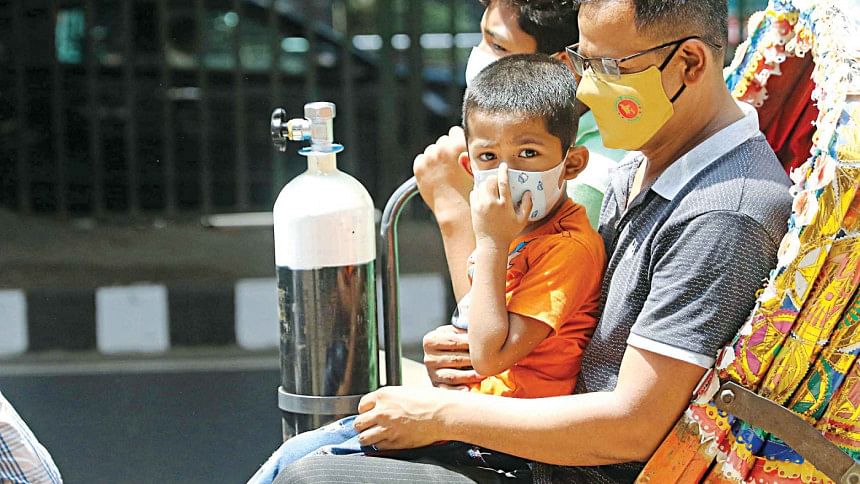Covid Treatment at Public Hospitals: Oxygen supply still dangerously low

With the number of infections and deaths from Covid-19 getting bigger, inadequate high-flow oxygen support at public hospitals has become a serious cause for concern.
Proper oxygen support for a critical Covid patient could be a matter of life and death and experts have put the blame squarely on the government for not being ready despite getting a year to prepare.
Since the beginning of the pandemic more than a year ago, experts have been insisting on adequate high-flow oxygen support at hospitals through a device called high-flow nasal cannula (HFNC). The devices are for patients whose oxygen saturation levels plummet due to the coronavirus infection.
The HFNC is a heated and humidified system that allows prescribed oxygen delivery at a high-flow rate, up to 60 litre per minute. This helps Covid-19 patients breathe and improve.
With normal oxygen masks, only oxygen can be supplied to a patient at no more than 15 litre per minute, according to physicians.
More than a year after the outbreak, the number of HFNCs available at the 10 Covid-19 dedicated hospitals in Dhaka city is inadequate to say the least.
According to the Directorate General of Health Services (DGHS), there are 178 HFNCs in these hospitals, which experts now believe cannot help every critical Covid patient.
Doctors in three Covid-19 dedicated hospitals in Dhaka expressed helplessness amid a rising number of critical patients and an inadequate number of HFNCs.
"No one can understand our incapacity and helplessness when we witness a patient's oxygen saturation going down to 50 percent. The air turns heavy with the grief of the patients' attendants. They appeal to us to transfer the patients to the intensive care unit, but there is no way to do so, as each ICU bed is occupied and there are 25 people on the wait-list," wrote a consultant at Mugda Medical College Hospital on Facebook.
Experts said if the high-flow oxygen support could be given on time, the lives of many in need of ICU support could be saved. More than five percent Covid-19 patients might need critical care, they added.
Farid Hossain Mian, director of hospitals and clinics at the DGHS, said, "We have increased the number of HFNCs and other equipment compared to last year. But it is still inadequate. We are working to send more HFNCs."
The DGHS has sought the supply of 102 more HFNCs to the 10 Covid-19 dedicated hospitals in Dhaka.
The situation outside Dhaka is bleak. There are only 720 HFNCs in government and private hospitals dedicated to Covid-19 patients.
In Chattogram, there are six HFNCs in Bangladesh Institute of Tropical and Infectious Diseases and Hospital and 60 more in Chattogram Medical College Hospital, according to the DGHS.
Prof Ridwanur Rahman, an infectious disease specialist, said, "The number of the high-flow nasal cannula is very inadequate. We have been insisting the authorities concerned to understand the necessity of high-flow oxygen. But the progress is still slow."
"It is a failure of planning on the part of the government," he told The Daily Star yesterday.
Echoing him, Prof Nazrul Islam, member of the National Technical Advisory Committee (NTAC) on Covid-19, said many deaths could have been avoided if there was an adequate number of HFNCs.
"The health directorate has failed to ensure a sufficient number of this device. Despite the prime minister's instructions to set up ICUs in district hospitals in June last year, the department could not complete it [the job] yet," he told The Daily Star yesterday.
"These are simply due to their indifference," he added.
"In terms of hospital management, we cannot see any government effort effective. Otherwise, why are so many patients dying?" Prof Nazrul said.
Contacted, Col Nazmul Haque, director of Dhaka Medical College Hospital, admitted that the number of HFNCs in his hospital was inadequate.
"We are struggling to deal with the rising number of patients complaining acute respiratory illness," he told this paper.
He, however, said there was a need for manpower to operate this device. "So increasing only the number of this device is not a solution."
The progress of setting up a central oxygen supply system, required for HFNCs to work, in the hospitals across the country is also dismal.
In June last year, the DGHS along with other government organisations and development partners took up multiple projects to install central oxygen supply systems in 124 hospitals.
Only 59 of them got the system so far. Installation is ongoing in the other hospitals, according to the DGHS.
HOSPITAL BEDS TO BE INCREASED
Health Minister Zahid Maleque yesterday said the government was working to turn the DNCC market in Mohakhali into a Covid-19 hospital.
According to the DGHS, there would be 50 ICU beds, 200 HDU beds and 1,000 isolation beds.
"The respective director has said to me today [Thursday] that it will need more than 10-12 days to launch the DNCC hospital," DGHS Director Farid told The Daily Star.
According to the DGHS data, there are 9,711 general beds and 586 ICU beds in Covid-19 dedicated hospitals across the country.
Nearly half – 4,165 – of the general beds and 370 ICU beds were occupied yesterday.
In Dhaka city, only four out of 108 ICU beds and 205 out of 2,511 general beds at Covid dedicated hospitals were vacant.

 For all latest news, follow The Daily Star's Google News channel.
For all latest news, follow The Daily Star's Google News channel. 



Comments